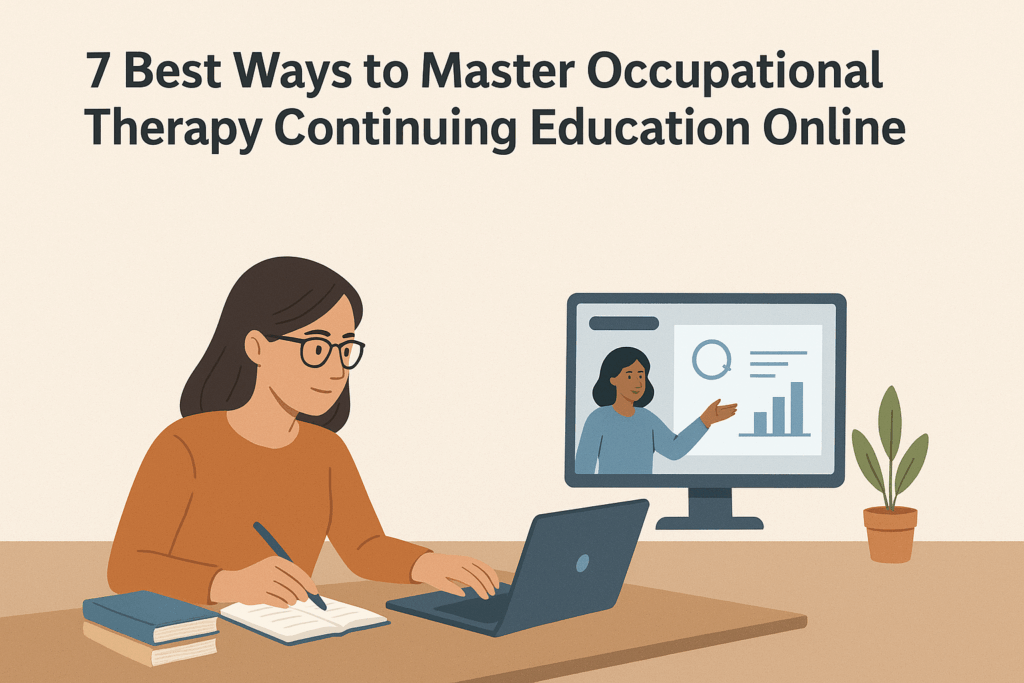7 Best Ways to Master Occupational Therapy Continuing Education Online
Filed under Uncategorized
Introduction to Occupational Therapy Continuing Education
What Is Occupational Therapy Continuing Education?
Occupational therapy continuing education refers to post-licensure training that helps occupational therapists maintain their credentials and stay updated with new techniques, theories, and practices. It’s a vital part of professional development, ensuring therapists remain competent in a rapidly evolving healthcare environment.
Why It Matters for OT Professionals
OTs face diverse patient needs across all ages and conditions. Staying educated means better patient outcomes, stronger career paths, and maintaining state licensure. It also signals a commitment to excellence and professionalism.

Benefits of Taking Continuing Education Courses Online
Flexibility and Convenience
Online courses allow you to learn from anywhere, anytime. Whether you’re balancing a job, family, or other responsibilities, online education fits your schedule.
Cost-Effective Options
Compared to traditional in-person classes, online OT education often costs less. There’s no need for travel, accommodation, or printed materials.
Wide Variety of Specializations
Online platforms offer hundreds of niche topics—from hand therapy to pediatric sensory integration. You can tailor your learning to your interests and clinical needs.
Accredited Online Platforms for OT Continuing Education
AOTA Approved Providers
The American Occupational Therapy Association (AOTA) approves a wide range of educational providers. Choosing an AOTA-approved course ensures quality and accreditation.
Hand Therapy Academy is an accredited AOTA partner that offers interactive courses, webinars, and self-paced modules.
Evaluating Course Credibility
Always verify:
- Provider accreditation
- Instructor credentials
- Course reviews and ratings
Choosing the Right Online OT Course
Aligning with Career Goals
Are you seeking a promotion, changing specialties, or boosting your skill set? Choose a course that aligns with those goals.
Reading Reviews and Testimonials
Real feedback from peers provides insight into course quality and relevance. Look for reviews on third-party platforms or forums.
Understanding Course Outcomes
Ensure the course has clear learning objectives, includes hands-on case studies, and offers post-assessment tools to test your knowledge.
Popular Course Topics in Online OT Education
Hand Therapy
- Carpal Instability
- Taping
- Sport Traumas
Neurological Rehabilitation
- Stroke recovery techniques
- Traumatic brain injury rehab
- Cognitive-perceptual training
Geriatric and Home Health Focus
- Fall prevention strategies
- Aging in place
- Adaptive equipment training
Certification and CEU Requirements for Occupational Therapists
Understanding CEUs and Licensure
CEUs (Continuing Education Units) are required to renew licenses. Most states require 12–36 hours (1.2 – 3.6 units) every 1–2 years.
State-by-State CEU Guidelines
Each U.S. state has different CEU mandates. Check your state’s occupational therapy board for specifics.
Maintaining AOTA Certification
For board-certified OTs, AOTA mandates ongoing professional development, including structured education and clinical hours.
Tips for Success in Online OT Continuing Education
Time Management Strategies
Create a weekly learning schedule, block study time, and minimize distractions.
Staying Motivated
Set small milestones and reward yourself upon completion. Join online study groups or communities for peer support.
Engaging with Instructors and Peers
Use discussion forums, Q&A sessions, and feedback tools. Networking adds depth to your learning experience.
Cost Breakdown of Online OT Continuing Education
| Category | Average Cost |
| Individual Course | $50 – $150 |
| Monthly Subscription | $20 – $120/month |
| Annual Membership | $250 – $1250/year |
Many platforms offer bulk discounts or free trials. AOTA members often receive additional savings.
How to Track and Report Your CEU Credits
Using Digital Portfolios
Tools like CE Broker allows easy documentation and uploads of certificates.
Submitting to State Boards
Most states require proof of completion—download certificates and keep copies for audits.
Automated Reporting Tools
Some platforms submit CEUs directly to licensing boards, simplifying your renewal process.
Integrating New Skills Into Clinical Practice
Case Studies and Real-World Application
Use new knowledge immediately. For instance, try a new pediatric intervention in a therapy session and evaluate the results.
Enhancing Patient Outcomes
Applying updated techniques boosts therapy success, leading to better satisfaction and outcomes.
Collaboration with Colleagues
Share your learning with coworkers—run short in-service trainings or present findings at staff meetings.
The Future of Online OT Continuing Education
Emerging Tech and Trends
Expect more virtual simulations, real-time patient case discussions, and AR-enhanced learning modules.
AI and Virtual Simulation in Training
AI can personalize your learning journey, recommend modules, and simulate clinical scenarios for practice.
Global Learning Opportunities
Online education removes borders. Learn from global experts or take internationally accredited OT courses.
Common Mistakes to Avoid When Choosing an Online OT Course
- Not Verifying Accreditation: Ensure the course counts toward your CEUs.
- Overlooking Course Objectives: If they’re vague, skip it.
- Skipping Peer Feedback: Community reviews often reveal course strengths and weaknesses.
Success Stories of Therapists Who Advanced Their Careers Online
Case Example #1: Pediatric OT
Jessica, a school-based OT, took an online taping course and introduced new classroom activities, improving student behavior and engagement.
Case Example #2: Neuro Rehab Specialist
Mark transitioned to a neuro-focused OT role after completing a 6-month online certification, boosting his salary and job satisfaction.
FAQs About Occupational Therapy Continuing Education Online
1. Is online CEU training accepted by all states?
Most states accept online CEUs, but always verify with your licensing board.
2. What is the best platform for occupational therapy continuing education online?
Top choices include Hand Therapy Academy and other AOTA-approved providers.
3. Can I take free OT CEU courses online?
Yes, several providers offer free introductory or trial courses, though premium content may require payment.
4. How many CEUs do I need to maintain my license?
It varies by state—typically between 12 to 36 CEUs every 1–2 years.
5. Are live webinars better than self-paced courses?
Both have benefits. Webinars offer interaction; self-paced modules allow flexibility.
6. How do I know if a course is AOTA-approved?
Look for the AOTA logo or check their list of approved providers on the AOTA website.
Conclusion: Take Charge of Your OT Career Today
The world of occupational therapy continuing education online offers unmatched opportunities for learning and career growth. With flexible formats, credible platforms, and endless course topics, there’s no better time to invest in your professional future. Choose wisely, stay committed, and turn knowledge into impact—your patients, career, and self will thank you.
More To Read
When should you use a Static Progressive Splint in Hand Therapy?
Flowers, K. (2002). A proposed decision hierarchy for splinting the stiff joint, with an emphasis on force application parameters. Journal of Hand Therapy, 15, 158–162. The Skinny- The article proposes a decision hierarchy to determine when you should apply a static progressive or dynamic orthosis. The decision hierarchy uses a modified Weeks test (MWT). The…
Read MoreDoes mirror therapy work for hand therapy patients with general orthopedic conditions?
By: Maddie Mott Rostami, R. H., Arefi, A., & Tabatabaei, S. (2013). Effect of mirror therapy on hand function in patients with hand orthopaedic injuries: a randomized controlled trial. Disability and Rehabilitation, 35(19). 1647-1651. DOI: 10.3109/09638288.2012.751132 The Skinny: How does mirror therapy work? Mirror therapy (MT) is performed by placing the patient’s injured extremity into…
Read MoreGraded Motor Imagery in Hand Therapy
The 3 Stages of Graded Motor Imagery We’ve all heard of mirror box therapy, but do you know the details of how it works? There’s actually 3 stages involved that exercise the brain and take advantage of its plasticity. There is a great deal of evidence supporting these three stages and you can use them…
Read MoreHand Therapy Interventions for Distal Upper Extremity Injuries and Conditions
Takata, S.C., Wade, E.T., & Roll, S.C. (2019). Hand therapy interventions, outcomes, and diagnoses evaluated over the last 10 years: A mapping review linking research to practice. Journal of Hand Therapy, 32(1), 1–9. Written by Brittany Carrie The Skinny Approximately 26.9% of orthopedic injuries and disorders of the upper extremity occur worldwide. Injuries are most…
Read MoreSign-up to Get Updates Straight to Your Inbox!
Sign up with us and we will send you regular blog posts on everything hand therapy, notices every time we upload new videos and tutorials, along with handout, protocols, and other useful information.






